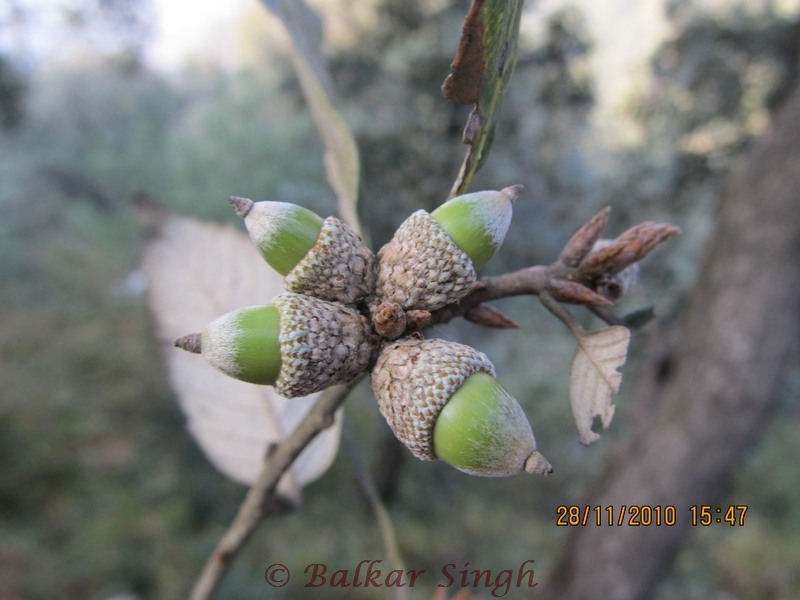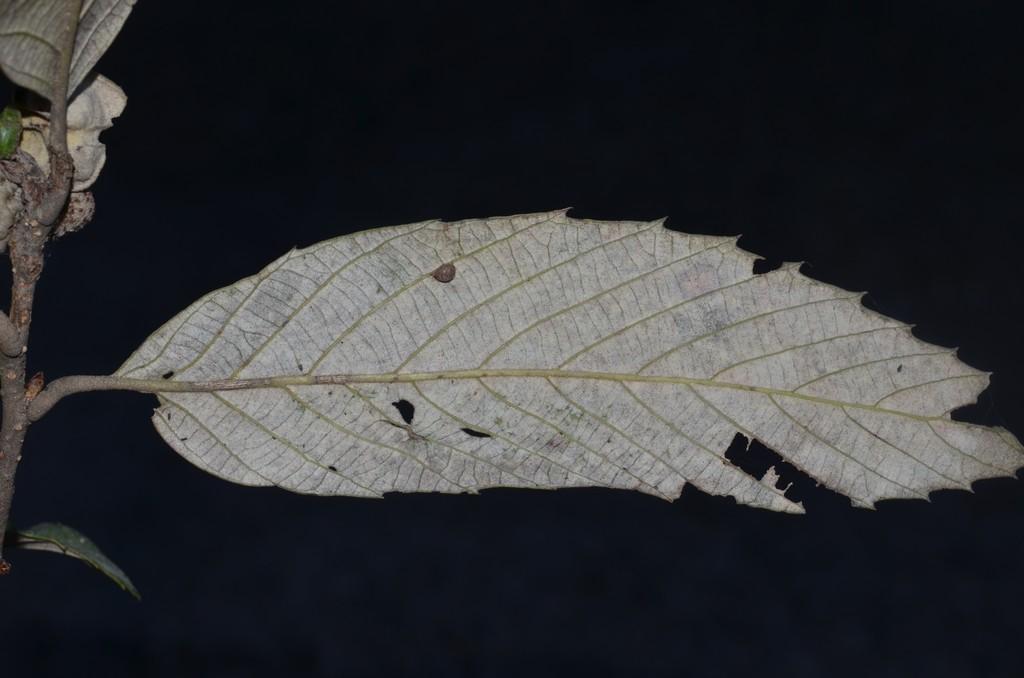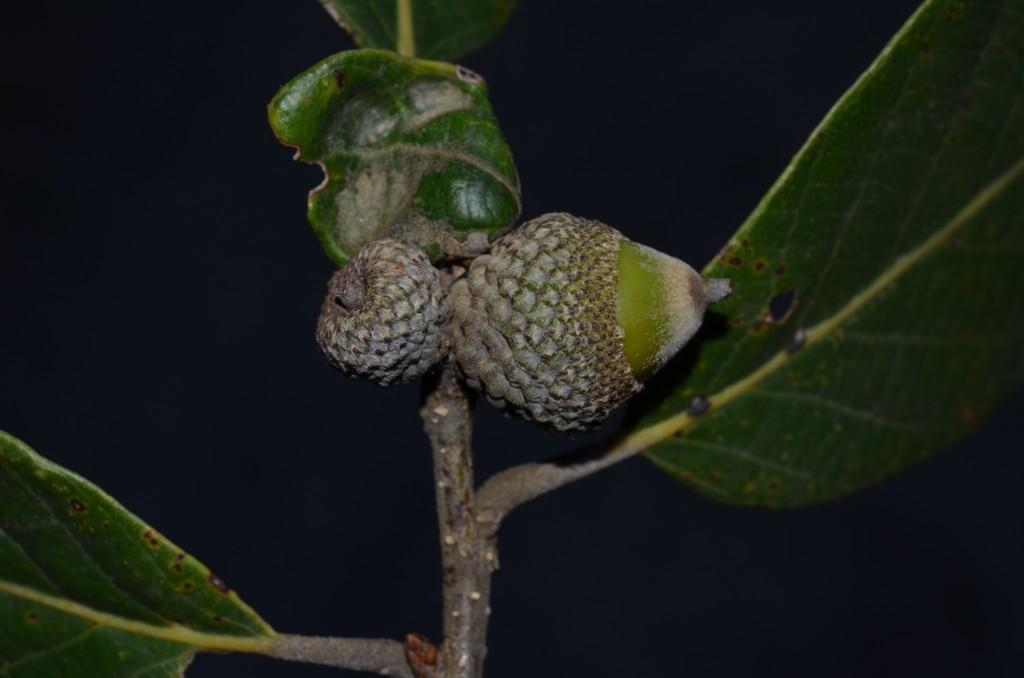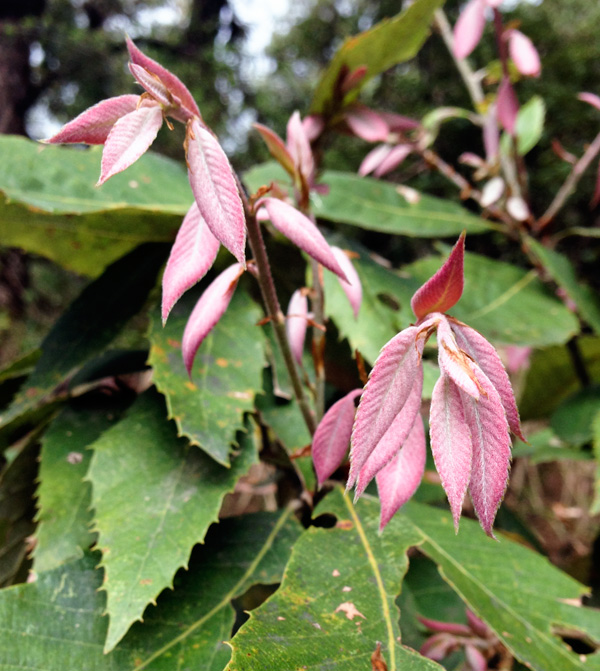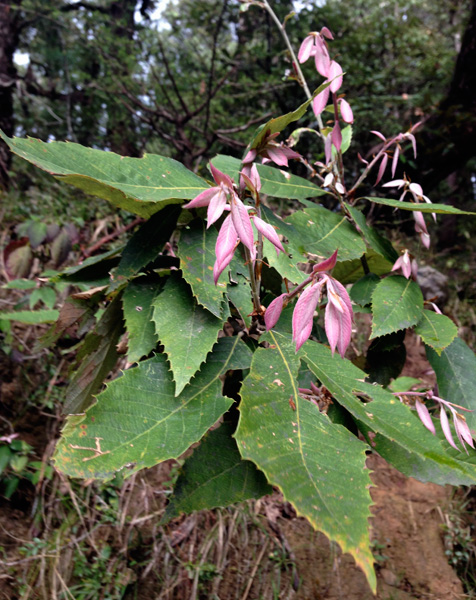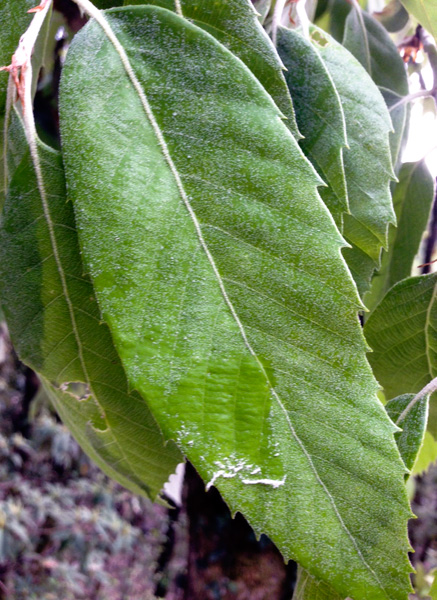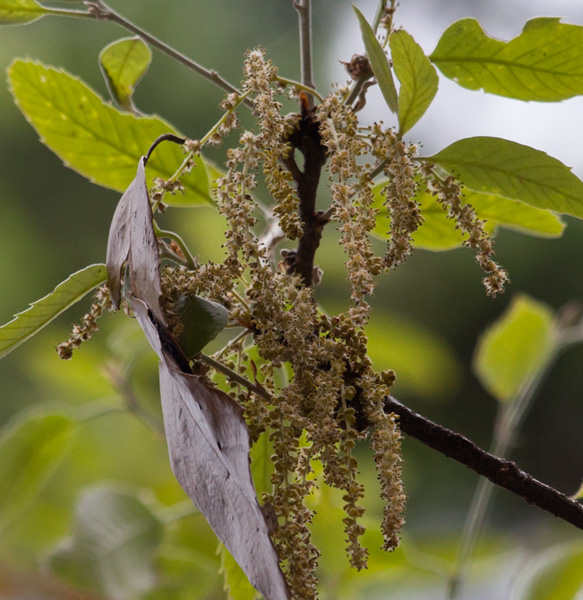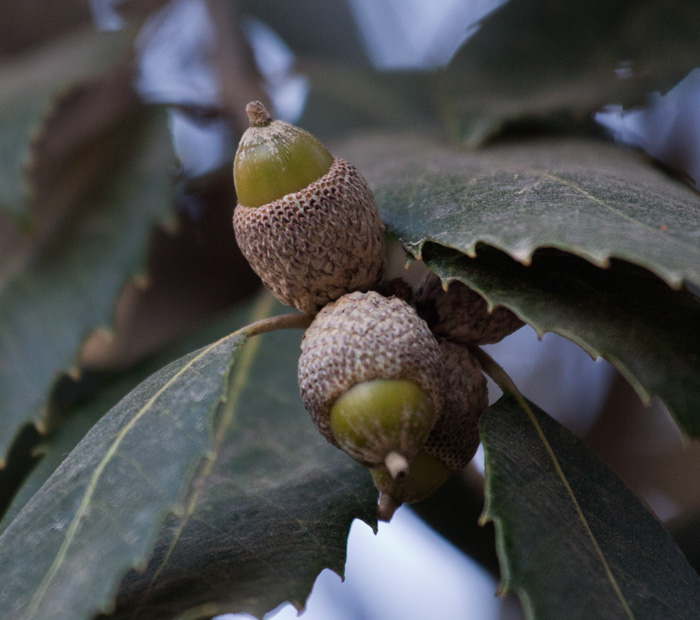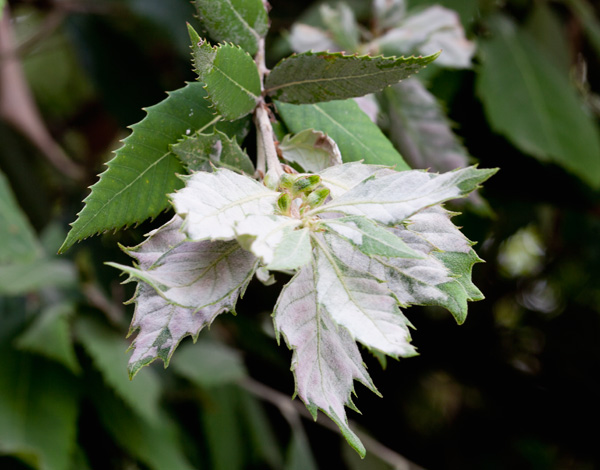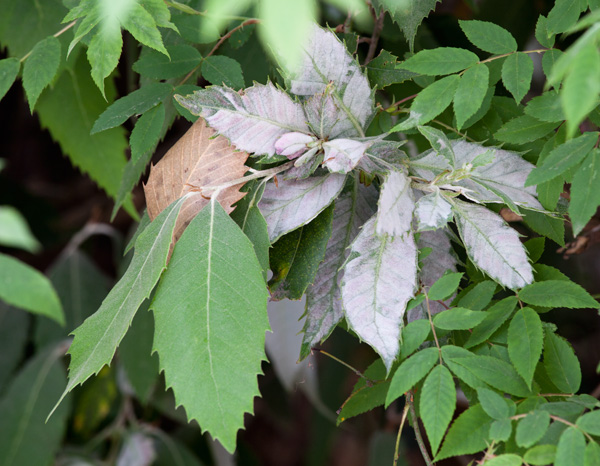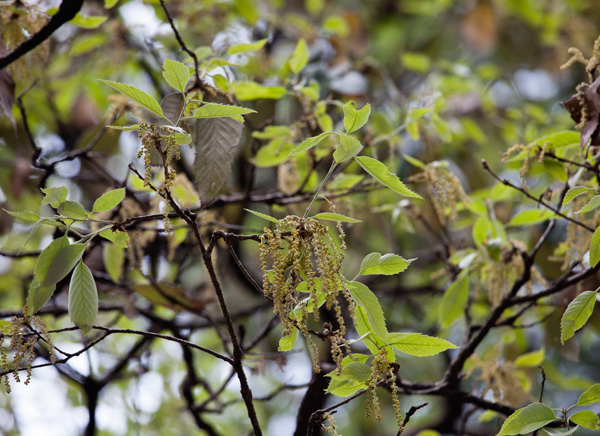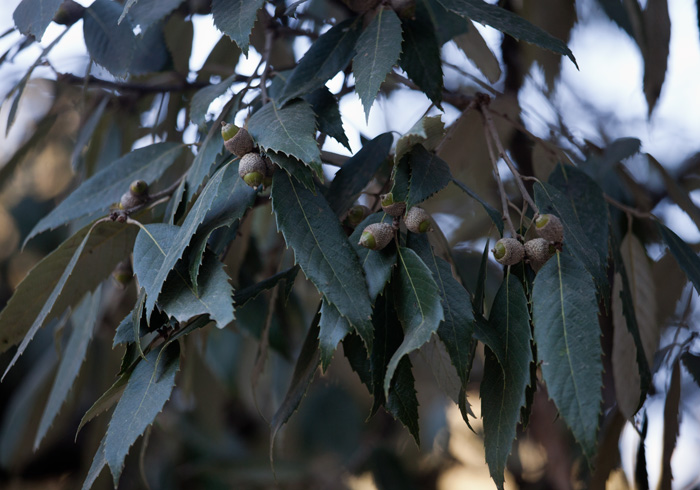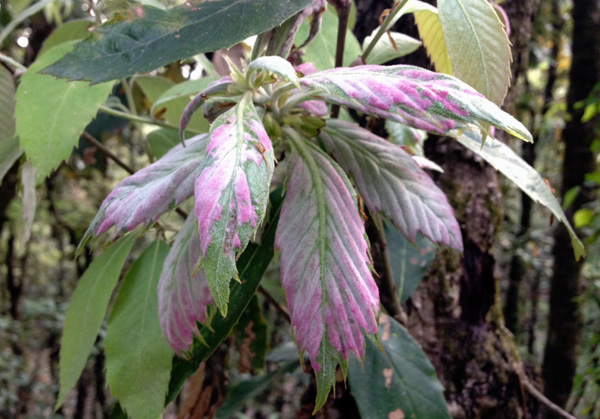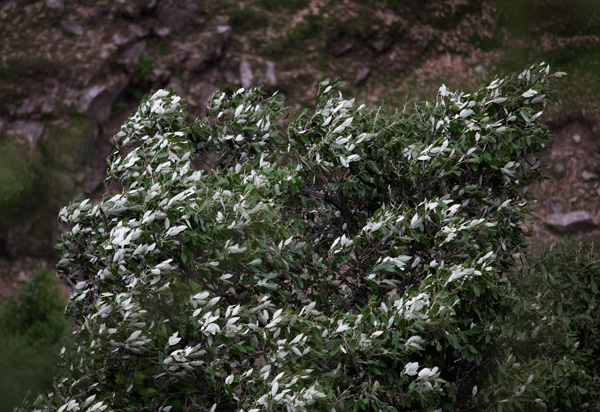|
Quercus oblongata D.Don, Prodr. Fl. Nepal. 57 1825. (Syn: Quercus dealbata Wall. [Invalid]; Quercus incana Roxb. [Illegitimate]; Quercus lanata var. incana Wenz.; Quercus leucotrichophora A.Camus ex Bahadur [Illegitimate]; Quercus leucotrichophora A.Camus) (Bhutan, China, N India, Myanmar, Nepal, N Thailand, Vietnam as per Flora of China)
.
Quercus lanata Sm., Cycl. 29: 27 1819. (syn: Quercus banga Buch.-Ham. ex D.Don; Quercus banga Ham. ex Hook.f.; Quercus lanata subsp. lanata ; Quercus lanuginosa D.Don [Illegitimate]; Quercus nepaulensis Desf.) (Sri Lanka, Himalaya to SC. China as per WCSP);
.
As per efi thread:
The story of Q. lanata and Q. oblongata (Syn Q. leucotrichophora) is very complex. Some authors consider them synonyms and some independent species. The recent classification of oaks has considered them the separate species BUT If you see the specimens used to describe the species, they all are located in Europe or the US. The Flora Of China considers them synonyms after studying them in the natural habitat.
IMHO,
1. For describing a species one must study it in its natural habitat i.e. Himalaya and adjacent region.
2. All the features used to describe Q. lanata and Q. oblongata is more or less the same. Some separate them with big acorn cups for Q. lanata and small for Q. oblongata but I observed so much variation in the size. Another feature used is the number of teeth on the leaf margin, which is also very variable in Q. oblongata that I have observed in its habitat (Himachal and Uttarakhand).
3. Another doubt is the distribution of Q. lanata. There are 2 views on this:
3a. It grows from west Himalaya to East and continues into China, Myanmar, North Thailand and Vietnam.
3b. It is absent in western Himalaya and starts from mid-Nepal to Sikkim, WB, Bhutan, Arunachal Pradesh, China, Myanmar, North Thailand and Vietnam.
4. The photographs I saw of Q. lanata from an arboretum located in Spain is the same as of any Q. oblongata I have seen in Himachal Pradesh and Uttarakhand.
5. There is also a third view of this conflict. It says that the Q. oblongata is a subspecies or variety of Q. lanata.
In reality, there is not enough data collected and research done to consider Q. lanata a separate species for now. China has done some ground research but nothing from India yet. There is a need for a proper field study on the species in India (not just Q. lanata but many other oak species).
.
Common name: Blackjack Oak, Grey Oak • Hindi: बांझ Banjh • Himachali: Vari, Ring • Kumaoni: Phanal
.
W. Pakistan, Himalaya (Kumaun to Nepal), Ceylon, ?Burma as per Annonated checklist of the flowering plants of Nepal
. Location: Nagarjun Forest reserve, Kathmandu Why not Quercus semecarpifolia Sm. as per images and details herein? I guess leaf pattern is more close to Q. lanata. can you tell us the sources of these photos? This is not Q. semecarpifolia. First reason, Q. semecarpifolia is a high altitude oak. It normally starts growing from 2500m to 4000m. Quercus lanata/ oblongata/ leucotrichophora grows from 1300m to 3000m.
Secondly, the leaves of Q. semecarpifolia are oval in shape with entire margin or with sharp teeth (normally on young shoots). The underside is brown/golden in colour. The leaves of Quercus lanata/ oblongata/ leucotrichophora are oblong in shape with toothed in apical half. The underside is white/ silver or sometimes yellowish white. I am attaching some photographs of leaves for better understanding.
Attachments (3) – 1 mb each.
Thanks, … Do you agree with … id ? Yes, It’s Q. oblongata (syn. Q. leucotrichophora/ Q. lanata). Is not Q. lanata is separate from Q. oblonggata (Syn Q. leucotrichophora)
WCSP gives both Quercus lanata Sm. & Quercus oblongata D.Don as accepted species as per details at links.
Pl. clarify. The story of Q. lanata and Q. oblongata (Syn Q. leucotrichophora) is very complex. Some authors consider them synonyms and some independent species. The recent classification of oaks has considered them the separate species BUT If you see the specimens used to describe the species, they all are located in Europe or the US. The Flora Of China considers them synonyms after studying them in the natural habitat.
IMHO,
1. For describing a species one must study it in its natural habitat i.e. Himalaya and adjacent region.
2. All the features used to describe Q. lanata and Q. oblongata is more or less the same. Some separate them with big acorn cups for Q. lanata and small for Q. oblongata but I observed so much variation in the size. Another feature used is the number of teeth on the leaf margin, which is also very variable in Q. oblongata that I have observed in its habitat (Himachal and Uttarakhand).
3. Another doubt is the distribution of Q. lanata. There are 2 views on this:
3a. It grows from west Himalaya to East and continues into China, Myanmar, North Thailand and Vietnam.
3b. It is absent in western Himalaya and starts from mid-Nepal to Sikkim, WB, Bhutan, Arunachal Pradesh, China, Myanmar, North Thailand and Vietnam.
4. The photographs I saw of Q. lanata from an arboretum located in Spain is the same as of any Q. oblongata I have seen in Himachal Pradesh and Uttarakhand.
5. There is also a third view of this conflict. It says that the Q. oblongata is a subspecies or variety of Q. lanata.
In reality, there is not enough data collected and research done to consider Q. lanata a separate species for now. China has done some ground research but nothing from India yet. There is a need for a proper field study on the species in India (not just Q. lanata but many other oak species).
I hope this will be helpful. Thank you … for the enlightenment. Fruits of Quercus leucotrichophora.
Yes Quercus leucotrichophora the underside of the leaf is white in colour . Images of Banj Oak flowers and fruits!!: I am looking for a good resolution picture of flowers of Banj Oak. I
would be grateful if anyone can send me. Images of any other part of the same plant will also be of great use to me. Your help will be thankfully acknowledged. Tree for ID : Uttarakhand : 110413 : AK-2 : Attachments (2). 4 posts by 3 authors. looks like Quercus sp (Fagaceae) Quercus leucotrichophora Tree For ID : Sattal,Uttarakhand : 080913 : AK-1 : Attachments (3). 3 posts by 2 authors. Quercus leucotrichophora A.Camus (Fagaceae). ‘Banj’/ Oak tree, considered as Green Gold of the Himalaya.
Chakrata
2nd November 2014 Beautiful capture … Thanks for Sharing This oak has to be the most common trees around here. Called ‘Ban’ locally, its leaves are used for cattle fodder and wood for stoves. These medium size trees always have an untidy look with twisting trunks and unruly canopy. Now acorns are aplenty and these looked so nice and fresh that I could not resist taking photographs.
Grey Oak–Quercus leucotrichophora
Mcleodganj, Dharamshala, HP
1750m approx.
03 December, 2014 Beautiful velvety pink leaves are sprouting on these oaks. Here are a couple of pictures from today. (29.3.15)
Attachments (2) lovely. hope springs eternal. cinnamon trees do the same Beautiful acorns. Now known as Quercus oblongata D.Don (Fagaceae). I found one tree in flower today and took some pictures to share. Mcleodganj, Dharamshala, HP
1750m
20 April 2015
7 images.
On Saturday the strong winds revealed the silvery underparts of oak leaves. I thought I will share this with you. 1 image. yes … is Correct. dianosis is right and delightful underside of leaves
longish acorns and long toothed leaves. pink when new
Quercus oblongata D.Don. : 4 posts by 2 authors. Attachments (6) Fruits seem to differ from images at Quercus oblongata Quercus serrata ?? but not listed in Nepal !
Most of the fruits look alike. Very difficult for me to ID correctly.
Appears close to images at Quercus oblongata D.Don as per comparative images at Quercus Thank you … for final validation of ID. Syn: Quercus leucotrichophora A. Camus SK1945 25 May 2019 : 2 posts by 2 authors. Attachments (4) – around 800 kb each.
Location: Nagarkot, Bhaktapur
Date: 16 May 2019
Elevation: 2029 m.
Habit : Wild Is this too Quercus lanata Sm. ?? Young branches dangling from the main branches.
Yes, should be Quercus oblongata as per details herein SK1942 24 May 2019 : 4 posts by 2 authors. Attachments (3)
Location: Nagarkot, Bhaktapur
Date: 16 May 2019
Elevation: 2020 m.
Habit : Wild Quercus lanata Sm. ??
Appears so as per images at Quercus oblongata Quercus oblongata : 2 posts by 1 author.
I did not want to join the group as I only have one question and maybe that could be sent to those listed under Quercus oblongata.
I would like to ask
Many now regard Q. oblongata as the correct name but has anyone seen the type specimen of Q. oblongata, or has anyone seen the first article that says this is the correct name for Q. leucotrichophora?
Also literature usually states that this species ripens fruits in 2 years but photos I see show annual ripening, sometimes ripe early the following year. Does anyone have observations on this? The Chinese say Q. leucotrichophora is biennial fruiting, Q. lanata is annual.
It seems likely that Q. oblongata, leucotrichophora and lanata are the same, in which case Q. lanata would be the correct name.
Also is there any record of Quercus tungmaiensis in India?
This is from Arunachal Pradesh and seems to be that species.
https://www.arboretumwespelaar.be/Default.aspx?L=E&WPID=312#gallerysearch-13 . Quercus for ID from Chaubatia Garden, Ranikhet-GS19032022-2: 4 very high res. images.
Please help with the ID of Quercus? sp. photographed from Chaubatia Garden, Ranikhet, 14-4-2012. Quercus glauca Thunb. ?? I think more close to images at Quercus oblongata D.Don arther than those at Quercus glauca Thunb. You seem to be right .
identify this acer species: 3 images.
Isn’t it Quercus.. leucotrichophora.. ? We have a page for this species at
https://efloraofindia.com/2011/04/12/quercus-oblongata/ To me also appears close.
. References (Quercus oblongata D.Don):
The Plant List Ver. 1.1 WCSP GRIN Annonated checklist of the flowering plants of Nepal Flora of China Flowers of India indianjournals References (Quercus lanata Sm.): |
Disclaimer
1. For any mistake in identification or for becoming efloraofindia e-group member (for contributing towards building of efloraofindia or otherwise), pl. mail to indiantreepix@googlegroups.com or itpmods@googlegroups.com
2. For better viewing of species’ pages, colour scheme & formatting is being followed as: Description of the species, Details of other flora species on the same page, Uses/ harms, Distribution, Abundance/ Location/ Flowering time & date, Habit & habitat, Etymology & pronunciation, Other interesting information, stories etc., Others, Botanical names, Common names, Main point of discussion below, Discussion about Botanical names.
Navigation
- Award for eFloraofIndia
- Colour scheme & formatting
- Copyrights, Permissions, Citations
- eFloraofIndia appreciated
- Names of Plants in India site
- Flowersofindia site
- Posting Guidelines
- For members’ information
- Logo, Tagline, Acronym
- Volunteers required
- ‘Pitamah’ of eFloraofIndia
- ‘अजेय’ ‘Ajey’ of eFloraofIndia
- ‘Saarthi’ ‘सारथि’ of eFloraofIndia
- ‘Jewel’ of eFloraofIndia
- ‘Grassman’ of eFloraofIndia

